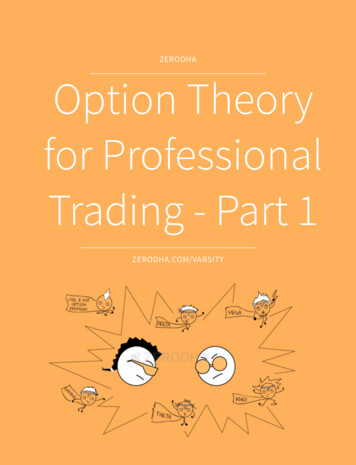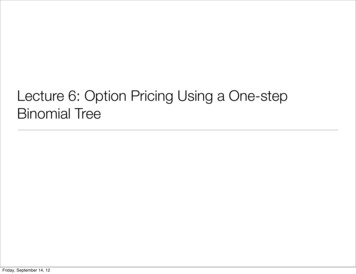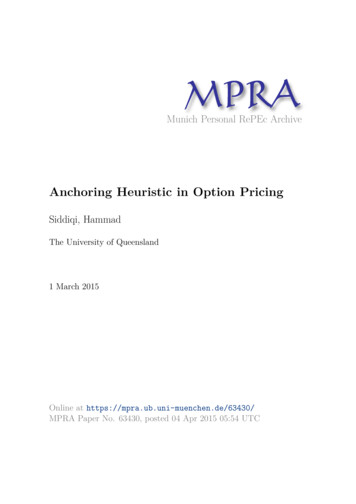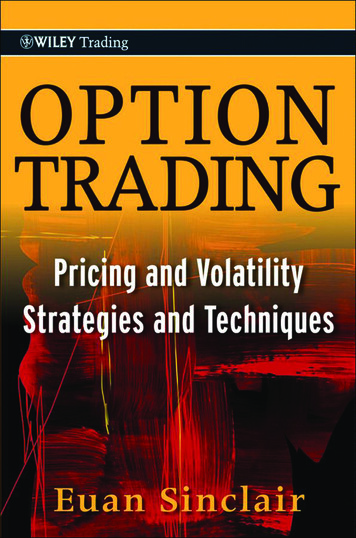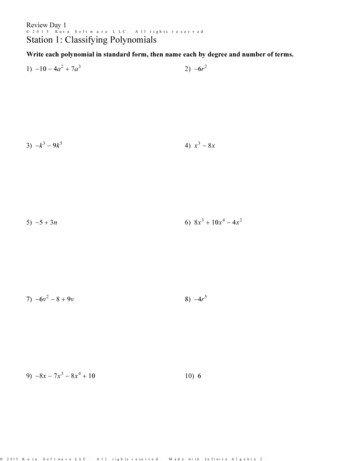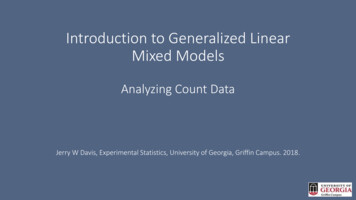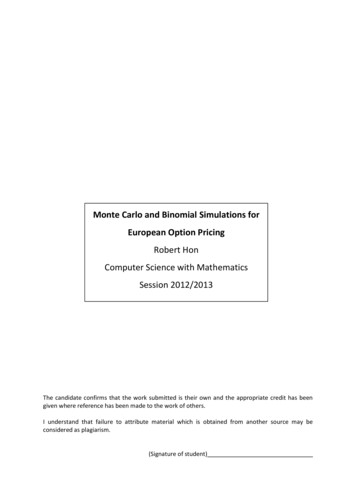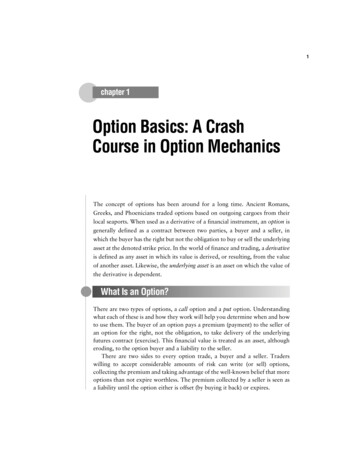
Transcription
Chapter 10Binomial Option Pricing: IQuestion 10.1.Using the formulas given in the main text, we calculate the following values:a)for the European call option:b)for the European put option: 0.5 0.5B 38.4316B 62.4513price 11.5684price 12.4513Question 10.2.a)Using the formulas of the textbook, we obtain the following results: 0.7B 53.8042price 16.1958b)If we observe a price of 17, then the option price is too high relative to its theoretical value.We sell the option and synthetically create a call option for 19.196. In order to do so, we buy 0.7units of the share and borrow 53.804. These transactions yield no risk and a profit of 0.804.c)If we observe a price of 15.50, then the option price is too low relative to its theoreticalvalue. We buy the option and synthetically create a short position in an option. In order to do so,we sell 0.7 units of the share and lend 53.8042. These transactions yield no risk and a profit of 0.696.Question 10.3.a)Using the formulas of the textbook, we obtain the following results: 0.3B 37.470788price 7.4707123
Part 3 Optionsb)If we observe a price of 8, then the option price is too high relative to its theoretical value.We sell the option and synthetically create a long put option for 7.471. In order to do so, we sell0.3 units of the share and lend 37.471. These transactions yield no risk and a profit of 0.529.c)If we observe a price of 6, then the put option price is too low relative to its theoreticalvalue. We buy the option and synthetically create a short position in the option. In order to do so,we buy 0.3 units of the share and borrow 37.471. These transactions yield no risk and a profit of 1.471.Question 10.4.The stock prices evolve according to the following picture:Since we have two binomial steps, and a time to expiration of one year, h is equal to 0.5. Therefore,we can calculate with the usual formulas for the respective nodes:t 0, S 100t 1, S 80t 1, S 130 0.691 0.225 1B 49.127B 13.835B 91.275price 19.994price 4.165price 38.725Question 10.5.S(0) 80:t 0, S 80delta0.4651B 28.5962premium8.6078t 1, S 64000124t 1, S 1040.7731 61.798018.6020
Chapter 10 Binomial Option Pricing: IS(0) 90:t 0, S 90delta0.5872B 40.6180premium12.2266t 1, S 72000t 1, S 1170.9761 87.777726.4223t 0, S 110delta0.7772B 57.0897premium28.4060t 1, S 880.4409 29.82298.9771t 1, S 1431 91.275051.7250t 0, S 120delta0.8489B 65.0523premium36.8186t 1, S 960.6208 45.810413.7896t 1, S 1561 91.275064.7250S(0) 110:S(0) 120:As the initial stock price increases, the 95-strike call option is increasingly in the money. Witheverything else equal, it is more likely that the option finishes in the money. A hedger, e.g., a marketmaker, must therefore buy more and more shares initially to be able to cover the obligation she willhave to meet at expiration. This number of shares in the replicating portfolio is measured by delta.The initial call delta thus increases when the initial stock price increases.Question 10.6.The stock prices evolve according to the following picture:125
Part 3 OptionsSince we have two binomial steps, and a time to expiration of one year, h is equal to 0.5. Therefore,we can calculate with the usual formulas for the respective nodes:t 0, S 100t 1, S 80t 1, S 130 0.3088 0.775 0B 38.569B 77.4396B 0price 7.6897price 15.4396price 0Question 10.7.S(0) 80:t 0, S 80 t 1, S 64 t 1, S 104delta 0.5350 1 770S(0) 90:deltaBpremiumt 0, S 90 t 1, S 72 t 1, S 117 0.4128 1 0.023947.078191.2753.49739.922619.2750.6973S(0) 110:t 0, S 110 t 1, S 88 t 1, S 143delta 0.2228 0.55910B30.606461.45210premium6.102212.25210S(0) 120:deltaBpremiumt 0, S 120 t 1, S 96 t 1, S 156 0.1511 0.3792022.643745.464604.51469.06460S(0) 130:t 0, S 130 t 1, S 104 t 1, S 169delta 0.0904 0.22690B14.681129.47700premium2.92715.87700126
Chapter 10 Binomial Option Pricing: IAs the initial stock price increases, the 95-strike put option is increasingly out of the money. Witheverything else equal, it is more likely that the option finishes out of the money. A hedger, e.g., amarket maker, must therefore sell fewer shares initially to be able to cover the obligation she willhave to meet at expiration. This number of shares in the replicating portfolio is measured by delta.The initial put delta thus tends towards zero when the initial stock price increases.Question 10.8.We must compare the results of the equivalent European put that we calculated in exercise 10.6.with the value of immediate exercise. In 10.6., we calculated:t 1, S 80t 1, S 130 0.775 0B 77.4396B 0price 15.4396price 0immediate exercise immediate exercisemax (95 80, 0) 15 max(95 130, 0) 0Since the value of immediate exercise is smaller than or equal to the continuation value (of theEuropean options) at both nodes of the tree, there is no benefit to exercising the options beforeexpiration. Therefore, we use the European option values when calculating the t 0 option price:t 0, S 100 0.3088B 38.569price 7.6897immediate exercise max (95 100, 0) 0Since the option price is again higher than the value of immediate exercise (which is zero), there isno benefit to exercising the option at t 0. Since it is never optimal to exercise earlier, the earlyexercise option has no value. The value of the American put option is identical to the value of theEuropean put option.Question 10.9.a)We can calculate the option delta, B and the premium with our standard binomial pricingformulas: 1B 46.296price 53.704127
Part 3 OptionsIt is no problem to have a d that is larger than one. The only restriction that we have imposed isthat d e(r δ)h e(0.07696)1 1.08, which is respected.b)We may expect the option premium to go down drastically, because with a d equal to 0.6,the option is only slightly in the money in the down state at t 1. However, the potential in the upstate is even higher, and it is difficult to see what effect the change in u and d has on the risk-neutralprobability. Let’s have a look at put-call-parity. The key is the put option. A put option with a strikeof 50 never pays off, neither in a) nor in b), because in a), the lowest possible stock price is 105, andin b), it is 50. Therefore, the put option has a value of zero. But then, the put-call-parity reduces to:C S Ke 0.07696 100 50 0.926 53.704.Clearly, as long as the strike price is inferior to the lowest value the stock price can attain atexpiration, the value of the call option is independent of u and d. Indeed, we can calculate: 1B 46.296price 53.704c)Again, we are tempted to think in the wrong direction. You may think that, since the calloption can now expire worthless in one state of the world, it must be worth less than in part b). Thisis not correct. Let us use put-call-parity to see why.Now, with d 0.4, a stock price of 40 at t 1 is admissible, and the corresponding put option hasa positive value, because it will pay off in one state of the world. We can use put-call-parity to seethat:C S Ke 0.07696 P 100 50 0.926 P 53.704 P 53.704.Indeed, we can calculate: 0.9B 33.333price 56.6666Question 10.10.a)We can calculate for the different nodes of the tree:node uu node ud dudelta10.8966B 92.5001 79.532call premium56.644115.0403value of early exercise54.144210.478128node dd0000
Chapter 10 Binomial Option Pricing: IUsing these values at the previous node and at the initial node yields:t 0delta0.7400B 55.7190call premium18.2826value of early exercise5node dnode u0.48700.9528 35.3748 83.20736.689733.1493027.1250Please note that in all instances the value of immediate exercise is smaller than the continuationvalue, the (European) call premium. Therefore, the value of the European call and the Americancall are identical.b)We can calculate similarly the binomial prices at each node in the tree. We can calculate forthe different nodes of the tree:node uu node ud dudelta0 0.1034B012.968put premium02.0624value of early exercise00node dd 192.500117.90420.404Using these values at the previous node and at the initial node yields:t 0delta 0.26B31.977put premium5.979value of early exercise0node d node u 0.513 0.04754.6916.85910.3871.0918.63070c)From the previous tables, we can see that at the node dd, it is optimal to early exercise theAmerican put option, because the value of early exercise exceeds the continuation value. Therefore,we must use the value of 20.404 in all relevant previous nodes when we back out the prices of theAmerican put option. We have for nodes d and 0 (the other nodes remain unchanged):deltaBput premiumvalue of early exerciset 0node d 0.297 0.59436.374 63.0056.67811.70908.6307The price of the American put option is indeed 6.678.129
Part 3 OptionsQuestion 10.11.a)We can calculate for the different nodes of the tree, taking into account the dividend yield:node uu node ud dudelta0.9740.6687B 92.5001 56.239call premium45.177310.635value of early exercise46.3985node dd0000We can see that for the node uu, the value of early exercise exceeds the continuation value. In thiscase, we exercise the American option early if we are at the node uu, and the value of the Americancall and the European call option will differ.We have for the European call option:deltaBcall premiumvalue of early exerciset 00.587 44.76013.9415node d0.354 25.0144.73040node u0.8124 70.88725.71923.911t 00.602 46.03714.1835node d0.354 25.0144.73040node u0.841 73.75926.26223.911and for the American call option:deltaBcall premiumvalue of early exerciseb)We can calculate similarly the binomial prices at each node in the tree for the put option:node uu node ud dudelta0 0.3049B036.262put premium05.767value of early exercise00node dd 0.973792.50023.63924.278Using those put premium values at the previous nodes and at the initial node yields:t 0delta 0.336B42.936put premium9.326value of early exercise0The price of the European put option is: 9.326.130node dnode u 0.594 0.13665.05219.17915.0683.0510.90350
Chapter 10 Binomial Option Pricing: Ic)From the previous tables, we can see that at the node dd, it is optimal to early exercise theAmerican put option, because the value of early exercise exceeds the continuation value. Therefore,we must use the value of 24.278 in all relevant previous nodes when we back out the prices of theAmerican put option. We have for nodes d and 0 (the other nodes remain unchanged):deltaBput premiumvalue of early exerciset 0node d 0.346 0.61644.0667.1779.5046 15.406010.903The price of the American put option is 9.5046.Question 10.12.a)We can calculate u and d as follows:u e(r δ)h σd h e(r δ)h σ h 0.25 e(0.08) 0.25 0.3 1.1853 0.8781 e(0.08) 0.25 0.3 0.25b)We need to calculate the values at the relevant nodes in order to price the European calloption:deltaBcall premiumt 00.6074 20.1874.110node d0.1513 4.57360.7402node u1 39.2088.204c)We can calculate at the relevant nodes (or, equivalently, you can use put-call-parity for theEuropean put option):European putdeltaBput premiumt 0 0.392618.2452.5414node d 0.848734.6344.8243node u000For the American put option, we have to compare the premia at each node with the value of earlyexercise. We see from the following table that at the node d, it is advantageous to exercise theoption early; consequently, we use the value of early exercise when we calculate the value of theput option.American putdeltaBput premiumvalue of early exerciset 0 0.396818.4412.56870131node d node u 0.8487034.63404.824304.87620
Part 3 OptionsQuestion 10.13.a)This question deals with the important issue of rebalancing a replicating portfolio. From theprevious exercise, part a), we calculate delta and B of the call option. We obtained:deltaBcall premiumt 00.6074 20.1874.110node d0.1513 4.57360.7402node u1 39.2088.204Therefore, at time t 0, we will buy 0.6074 shares of the stock and borrow 20.187 from the bank.This will cost us 4.110, and our proceeds from the sold option are 5, which yields a total profitof 0.89.b)Suppose that in the next period, we are in state u (without loss of generality). At that point,the stock price is u S0 1.1853 40 47.412. Since we assume that the call is fairly priced,we can buy a call to offset our written call for 8.204. We sell our 0.6074 shares for 28.798, andwe pay back the money we borrowed, plus accrued interest: 20.187 e0.08 0.25 20.5948. Thus,our total cash flow is 28.798 8.204 20.5948 0 (small differences due to rounding). Wesee that we were perfectly hedged, and have no cash outflow in period 1.If the option continued to be overpriced, we would have to change the replicating portfolio accordingto the above table (i.e., in state u, we would buy an additional 1 0.6074 shares and take on anadditional loan of 39.208 20.187 to finance it) and stick with our option until the final period. Inthe final period, the payoff from the option exactly offsets our obligation from the hedging position,and again, there would be no cash outflow.c)If the option were underpriced, we would liquidate our position as in part b), but couldmake an additional profit, because we could buy the offsetting option for less than it is worth. Evenbetter, if we could buy more than one option at the advantageous price, we could build up anotherarbitrage position, entering into a position where we buy the cheap option and replicate the shortposition synthetically.Question 10.14.a)We can calculate the price of the call currency option in a very similar way to our previouscalculations. We simply replace the dividend yield with the foreign interest rate in our formulas.Thus, we have:node uu node ud dudelta0.99250.9925B 0.8415 0.8415call premium 0.47340.1446132node dd0.1964 0.13140.0150 p
We sell the option and synthetically create a call option for 19.196. In order to do so, we buy 0.7 units of the share and borrow 53.804. These transactions yield no risk and a profit of 0.804. c) If we observe a price of 15.50, then the option price is too low relative to its theoretical value. We buy the option and synthetically create a short position in an option. In order to do so,

